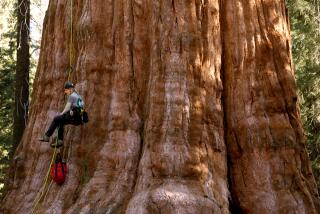Effort to Clone Bristlecone Pine Fails
- Share via
A nonprofit tree cloning organization has failed to create an exact genetic replica of the oldest known tree on Earth -- a bristlecone pine dubbed Methuselah that clings to arid soil in California’s White Mountains. But the group managed to coax a crop of seedlings from the ancient tree’s cones in what the group’s co-founder calls a partial victory.
Because the 2-inch sprouts grew from seeds, they also contain genetic material of another parent tree.
The Michigan-based Champion Tree Project International was granted special permission in October to clip cuttings, needles and cones from the 4,768-year-old Methuselah. In a stealth procedure, a U.S. Forest Service manager led the team to the tree, whose precise location is carefully guarded to avert vandalism.
Seeds of the ancient pine have been germinated in previous experiments, although it’s unclear what became of the trees, said John Louth, forest manager of the Ancient Bristlecone Pine Forest. Cloning the tree by getting the cuttings to root would have been a first, but those efforts failed, said David Milarch, the tree group’s co-founder.
Still, the seedlings are a start, said Milarch, who hopes to take another stab at cloning the tree from cuttings, but earlier in the season. The group also hopes to graft cuttings from Methuselah onto the seedlings at a later date, creating a genetic twin on top of the offspring’s roots.
“I think it’s great,” Milarch said. “It’s seedlings from the world’s oldest tree. It’s pretty amazing those cones still work. And it gives us the root stocks to graft on a bud at a later date.”
A fifth-generation shade tree farmer, Milarch founded the organization with his son, Jared, in 1996. Their goal: to preserve the genetic material of the hardiest trees -- the largest and sometimes the oldest -- before they are lost forever.
The seedlings were sprouted by Bill Werner, a Monterey tree propagator who has successfully cloned Monterey pines from needle bundles.
Werner successfully sprouted nine of 10 seeds from Methuselah’s cones and nine of 10 seeds from the Champion, the largest known bristlecone, though much younger than Methuselah. One of each will be donated by the Michigan group and the U.S. Forest Service to the U.S. Botanic Garden in Washington, D.C., this summer.
“We know who the mother is, but we don’t know who the father is,” Werner said.
Louth noted that the deadbeat dad is probably from the same grove as Methuselah, which is dotted with the oldest known bristlecones. So both parents are hardy survivors.
The trees grow on arid, inhospitable slopes in a corner of the Inyo National Forest. Their longevity, Louth notes, comes because of adversity, not in spite of it. If the seedlings are treated too well by their new owners -- given moisture and good soil -- they may succumb to disease, he said.






